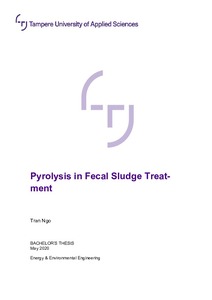Pyrolysis in fecal sludge treatment
Ngo, Tran (2020)
Ngo, Tran
2020
All rights reserved. This publication is copyrighted. You may download, display and print it for Your own personal use. Commercial use is prohibited.
Julkaisun pysyvä osoite on
https://urn.fi/URN:NBN:fi:amk-2020052513499
https://urn.fi/URN:NBN:fi:amk-2020052513499
Tiivistelmä
Excreta is an indispensable part of human everyday life. If these fecal sludgesare not managed properly and discharged into the environment, they can causesevere waterborne diseases as well as water pollution that deteriorates publichealth and the living habitat.
Pyrolysis, a process of thermal decomposition of organic materials under the inert condition in an oxygen‐deficient environment, is a potential fecal sludge treatment with marketable byproducts, especially biochar.
The main objective of the thesis was to conduct a literature survey and make a comparison of different technological options of pyrolysis use in fecal sludge treatment. Three different pyrolysis uses in fecal sludge treatment were analysed: Sol-char toilet, an onsite treatment integrated with pit-latrine for household use, a small scale biochar reactor to serve a community of 100 people in Kenya and the industrial scale Greenlife pyrolysis plant.
The results show that all the pyrolysis technologies produce 100% pathogen elimination. Hygiene is satisfied and equal for all meanwhile the pyrolysis plant is dominant when the criteria are effectiveness, odor emission control and sustainability. Besides, the innovative use of solar energy powering pyrolysis design poses a great idea for sustainable development. Production cost overlaps the byproduct benefit and more improvement is required to minimise price and for long-term investment to be profitable.
In conclusion, these three cases with different pyrolysis scales and technologies have both pros and cons. However, through the literature review of the three cases in specific and the pyrolysis fecal sludge in general, pyrolysis technology has proved to be feasible as a sanitation solution for fecal sludge treatment and potential energy recovery via biochar and syngas production. To better understand the potential of fecal sludge pyrolysis to safely and cost-effectively determine the technical feasibility and financial resource requirement of implementing pyrolysis as a fecal sludge treatment process, further improvement studies and experiments are needed.
Pyrolysis, a process of thermal decomposition of organic materials under the inert condition in an oxygen‐deficient environment, is a potential fecal sludge treatment with marketable byproducts, especially biochar.
The main objective of the thesis was to conduct a literature survey and make a comparison of different technological options of pyrolysis use in fecal sludge treatment. Three different pyrolysis uses in fecal sludge treatment were analysed: Sol-char toilet, an onsite treatment integrated with pit-latrine for household use, a small scale biochar reactor to serve a community of 100 people in Kenya and the industrial scale Greenlife pyrolysis plant.
The results show that all the pyrolysis technologies produce 100% pathogen elimination. Hygiene is satisfied and equal for all meanwhile the pyrolysis plant is dominant when the criteria are effectiveness, odor emission control and sustainability. Besides, the innovative use of solar energy powering pyrolysis design poses a great idea for sustainable development. Production cost overlaps the byproduct benefit and more improvement is required to minimise price and for long-term investment to be profitable.
In conclusion, these three cases with different pyrolysis scales and technologies have both pros and cons. However, through the literature review of the three cases in specific and the pyrolysis fecal sludge in general, pyrolysis technology has proved to be feasible as a sanitation solution for fecal sludge treatment and potential energy recovery via biochar and syngas production. To better understand the potential of fecal sludge pyrolysis to safely and cost-effectively determine the technical feasibility and financial resource requirement of implementing pyrolysis as a fecal sludge treatment process, further improvement studies and experiments are needed.
